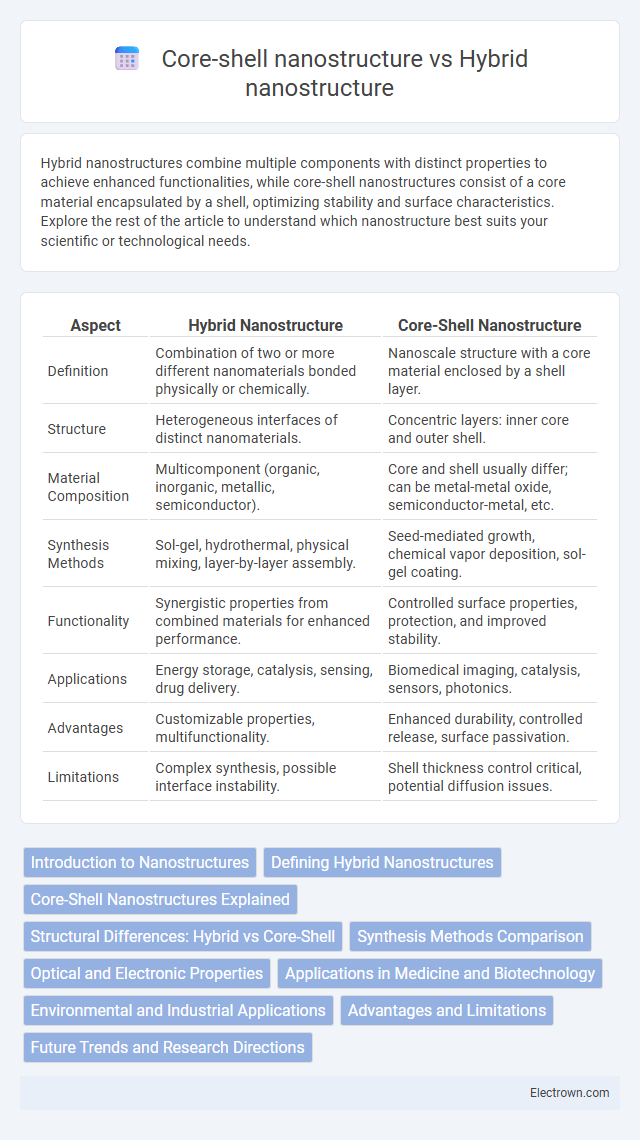Hybrid nanostructures combine multiple components with distinct properties to achieve enhanced functionalities, while core-shell nanostructures consist of a core material encapsulated by a shell, optimizing stability and surface characteristics. Explore the rest of the article to understand which nanostructure best suits your scientific or technological needs.
Table of Comparison
| Aspect | Hybrid Nanostructure | Core-Shell Nanostructure |
|---|---|---|
| Definition | Combination of two or more different nanomaterials bonded physically or chemically. | Nanoscale structure with a core material enclosed by a shell layer. |
| Structure | Heterogeneous interfaces of distinct nanomaterials. | Concentric layers: inner core and outer shell. |
| Material Composition | Multicomponent (organic, inorganic, metallic, semiconductor). | Core and shell usually differ; can be metal-metal oxide, semiconductor-metal, etc. |
| Synthesis Methods | Sol-gel, hydrothermal, physical mixing, layer-by-layer assembly. | Seed-mediated growth, chemical vapor deposition, sol-gel coating. |
| Functionality | Synergistic properties from combined materials for enhanced performance. | Controlled surface properties, protection, and improved stability. |
| Applications | Energy storage, catalysis, sensing, drug delivery. | Biomedical imaging, catalysis, sensors, photonics. |
| Advantages | Customizable properties, multifunctionality. | Enhanced durability, controlled release, surface passivation. |
| Limitations | Complex synthesis, possible interface instability. | Shell thickness control critical, potential diffusion issues. |
Introduction to Nanostructures
Hybrid nanostructures combine multiple materials at the nanoscale to enhance properties such as optical, magnetic, or catalytic performance, offering multifunctional applications. Core-shell nanostructures consist of a distinct core material encapsulated by a shell layer, providing stability, controlled interactions, and tailored surface functionality. Understanding these nanostructures helps you select the appropriate design for specific technological or biomedical uses.
Defining Hybrid Nanostructures
Hybrid nanostructures combine two or more distinct nanoscale materials or components to achieve synergistic properties that are not present in individual constituents. These architectures often integrate metals, semiconductors, or polymers, enabling enhanced electronic, optical, or catalytic performance. Unlike core-shell nanostructures, which consist of a core material encapsulated by a shell layer, hybrid nanostructures may exhibit heterogeneous interfaces and complex arrangements for multifunctionality.
Core-Shell Nanostructures Explained
Core-shell nanostructures consist of a central core material encapsulated by a distinct shell layer, enhancing properties like stability, reactivity, and optical behavior. These structures enable precise control over electronic and chemical characteristics by varying core and shell compositions, crucial for catalysis, drug delivery, and photonic applications. Your research benefits from the tailored interfaces and improved performance offered by core-shell designs compared to hybrid nanostructures, which combine different materials without a layered configuration.
Structural Differences: Hybrid vs Core-Shell
Hybrid nanostructures combine multiple materials at the nanoscale in a mixed or integrated manner, allowing for diverse functionalities within a single particle. Core-shell nanostructures consist of a distinct core material encapsulated by a shell layer, providing a clear boundary that enhances stability and tunable surface properties. Your choice depends on whether you need the synergistic effects of mixed materials in hybrids or the protective, controllable features of core-shell architectures.
Synthesis Methods Comparison
Hybrid nanostructures are commonly synthesized using methods like sol-gel processing, chemical vapor deposition, and electrochemical techniques, which enable the integration of distinct materials with tailored interfaces. Core-shell nanostructures typically rely on layer-by-layer assembly, epitaxial growth, or seed-mediated synthesis to precisely control shell thickness and composition around a core material. The synthesis of hybrid nanostructures emphasizes multifunctional integration through combining diverse components, whereas core-shell synthesis focuses on uniform shell coverage and interface engineering for enhanced stability and performance.
Optical and Electronic Properties
Hybrid nanostructures exhibit enhanced optical properties such as broader absorption spectra and increased photoluminescence compared to core-shell nanostructures, due to the synergistic interaction between distinct material components. Core-shell nanostructures provide superior electronic stability and controlled charge carrier dynamics by spatially separating the core and shell materials, reducing surface defects and nonradiative recombination. These differences make hybrid nanostructures ideal for applications requiring tunable optical responses, while core-shell configurations are preferred for stable electronic devices like quantum dots and photovoltaics.
Applications in Medicine and Biotechnology
Hybrid nanostructures, combining multiple materials at the nanoscale, offer enhanced functionalities such as improved drug delivery, bioimaging, and biosensing in medicine and biotechnology. Core-shell nanostructures provide controlled release and targeted therapy by encapsulating active agents within protective shells, crucial for precision medicine and diagnostic applications. Your choice between these nanostructures depends on the specific therapeutic or diagnostic requirement, balancing multifunctionality and structural stability.
Environmental and Industrial Applications
Hybrid nanostructures offer enhanced multifunctionality by combining distinct materials, improving catalytic efficiency and pollutant degradation in environmental remediation. Core-shell nanostructures provide tailored surface properties and stability, making them ideal for controlled drug delivery and industrial catalysis under harsh conditions. Their distinct architectures enable targeted performance optimization in applications such as water purification, renewable energy, and chemical synthesis.
Advantages and Limitations
Hybrid nanostructures offer enhanced multifunctionality by integrating distinct materials, leading to improved optical, electronic, and catalytic properties compared to core-shell nanostructures. Core-shell nanostructures provide superior stability and controlled surface chemistry due to their well-defined core and shell interfaces, but often face limitations in tunability and complexity in synthesis. Both structures exhibit unique advantages: hybrids excel in property diversification, while core-shell designs ensure protection and targeted functionality, with limitations primarily in fabrication scalability and structural uniformity.
Future Trends and Research Directions
Future trends in hybrid nanostructure research emphasize multifunctional applications by integrating diverse material properties, enhancing catalytic efficiency, and improving electronic and photonic device performance. Core-shell nanostructures are advancing towards precise control over shell thickness and composition to optimize stability, biocompatibility, and targeted drug delivery. Emerging research directions include scalable synthesis methods, real-time structural characterization, and the development of stimuli-responsive nanostructures for smart biomedical and environmental applications.
Hybrid nanostructure vs Core-shell nanostructure Infographic

 electrown.com
electrown.com